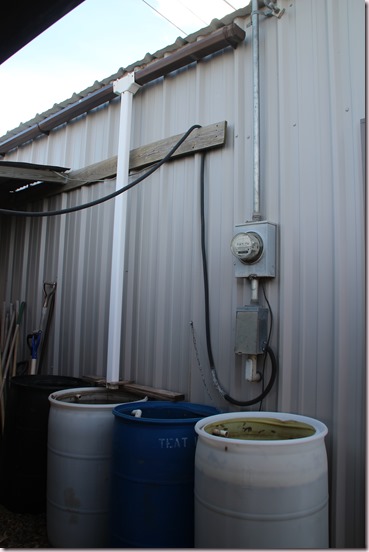
We added two new rain barrels for collecting rain water-yes it does occasionally rain here-and snow, which is supposed to hit tonight, so I thought I’d share my barrel system with you in case you’d like to try it yourself.




Rain can be collected in all sorts of containers, but we chose to buy the empty plastic barrels from Muleshoe Vet Supply that contained detergents and various liquid treatments that they supply to the local dairies to clean and treat cow udders. The barrels must be rinsed out before you use them, but any residue that might remain would not be harmful to plants or animals. And being plastic, the barrels are light-weight which is a bonus when transporting and handling them, and the plastic top is easy to cut out with a reciprocating saw. And yes, the top has to be cut out because that is how you collect the rain!
Now, you could just cut out the top and let the raindrops fall where they may, but a more efficient collection method is to use a rain gutter to catch the roof runoff and direct it into the barrel. So my clever husband put up some extra gutter we had and connected that to a downspout that empties into one of the barrels. Then he drilled holes in the touching sides for a piece of PVC pipe so that as the main barrel with the downspout in it fills up, the water drains into the adjoining barrels, allowing us to collect more water. Cool, huh? It works really well, and unless we are blessed with a real gully-washing, turd-floating downpour, the barrels usually have room for all the rain that collects.
If you look closely, you can see we have the downspouts anchored above the main barrel to keep them from moving around during a heavy rain. When it rains up here, it is usually accompanied by high winds, which blow the downspout all over the place and the water runs off on the ground and not into the barrel. That may or may not be an issue where you live, but it is probably a good idea to make the downspout stay put just to be sure the water goes where you want it to.
I dip water from the open top with my watering pitcher when I am ready to water plants. If you want to put your barrels up off the ground to create gravitational pressure and add a faucet on the bottom after you have cut out the top, you could fill your watering container from the faucet or you could connect a drip line for watering flower beds, which my son has done with his barrels. Dipping from the top works for me, and my barrels aren’t close to any flower beds, so I am happy with the dip and water method.
If your water stands too long during the summer, you do have to watch out for mosquito larvae. A small drop of oil or a bit of dish soap added to the water usually takes care of it. Leaves will collect in the water if you have many trees nearby, but they can be dipped out, and those that sink to the bottom decompose, adding what I would like to think is a bit of plant food to the water. Right now the big issue is the water freezing in the cold weather, and the top five or so inches become solid ice. I have no answer for that, other than wait for a break in the weather for the ice to melt. I have also been known to fill five-gallon buckets and my watering cans before the water freezes and set those containers in the greenhouse and barn so I will have usable water during the freeze. 
As you can see here and in the other pictures, the water is frozen as we speak and the low tonight is supposed to be 27, the high tomorrow around 30 as a new cold front comes through. This water won’t be usable for a few days.
I think rain barrels are a great idea for two main reasons: plants like the rain water, and conserving water just makes sense. Water is precious, in or out of West Texas, in or out of a drought, and rain barrels make a share of the water available for me to use while the rest of the rain makes it way down into the earth to replenish the water table below, which, obviously, is also necessary.

So unless you live in Colorado, where I understand rain barrels are illegal, you might want to give it a try. The process has worked well for my plants and me.
Recent Comments